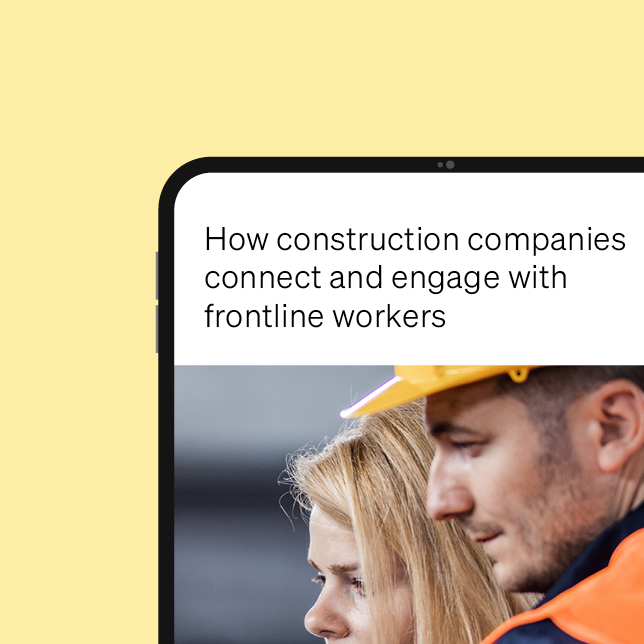From desk-sitters to frontline workers, construction companies urgently need to create cohesive, engaging employee experiences for their workforces. It’s a big ask, but the gains are substantial.
Traditionally, frontline industries have lagged concerning digital transformation and change management. New conversations, however, reveal significant developments are needed, and some are underway. And not a moment too soon.
Construction workers are disconnected
Recent research indicates low levels of connection to frontline workers, partly caused by the lack of suitable technology and infrequent communication. The good news is that construction companies recognize that poor engagement negatively impacts productivity. And they also see the technology gap making it difficult to attract and retain talent, so there’s clearly a need to push for change.
In our ebook How construction companies connect and engage with frontline workers, we explore pain points in the sector to identify needs, and how to handle the challenge and disruption that new technology so often brings.
We look at construction industry recommendations and draw from customer insights to show how some early adopters of employee engagement platforms are succeeding. And we offer guidance to help you get ahead with an employee engagement program suited to your workforce’s specific needs.
Understanding its unique challenges

Working in the construction sector today is more challenging than ever. Costs are up across the board, supply chains are struggling, and there’s a labor shortage. The industry is no longer about using your hands, and there’s a race to keep up with ever-advancing technological tools of the trade. And then there’s the weather to contend with too.
There are a number of challenges to contend with and when combined with inadequate support, workers tend to look around for better jobs. Recruiting and re-skilling new workers costs a lot when employee turnover rates are high. This means that, as a priority, companies must address the underlying causes of employee disengagement.
Getting communication right is a big issue, and a complex one at that. Companies must effectively and professionally engage with clients, suppliers, contractors, subcontractors, and workers of all skill levels and across many locations. Effective coordination, connection, and communication between so many teams and individuals is daunting, and it’s important to understand how to fold in employee engagement. It’s an essential piece of the communication puzzle as it drives cohesion and enhances safety, which is crucial.
Frontline safety first
Safety is a constant, major concern in the sector and low employee engagement exacerbates it. Low employee engagement leads to poor productivity and opens the workforce and people around them to huge risks.
Lacking the ability to share knowledge, it just isn’t. As a result, information and updates from all sources across any number of job sites does not reach its intended audience. This makes it difficult, if not impossible, for workers to do a good, safe job. Disconnects are dangerous, as missed information can cause errors, and our ebook helps construction companies identify what is missing and how to fix it. Solutions not only enhance employee engagement and contribute toward keeping people safe but also helps protect a company’s reputation.
Keeping a distributed frontline workforce connected and coordinated is challenging considering the levels of design, management, and execution that make up the construction sector, so it makes sense to invest in a top-quality communication platform. This is essential for project management and communicating deadlines, and it also helps frontline workers feel recognized and motivated.
Getting back what you give

A two-way communication system allows frontline construction workers to find support when and where they need it. And a frontline worker who feels like they’re a valued part of the team tends to be more productive, and this positively impacts everything from safety to company revenue.
Frontline workers may already be dealing with feelings of isolation and exclusion. They need to be kept informed about ongoing operations and particularly about changes. You can be sure that they won’t appreciate receiving second-hand news on an issue that affects them, as no one does! Keeping employees constantly aligned with changes, and being aware of their sentiments toward changes reduces the chance of costly disruption.
There’s also an age gap to consider.
Addressing the age gap
More and more people, especially younger generation workers, prioritize a good company culture when job hunting. Hence, construction industries need to pay close attention to this trend to attract and retain this talent. And when a workforce is considerably distributed, creating and sustaining a healthy culture is particularly challenging.
Companies must rethink their approach to workforce development and internal environments to accommodate. The aging construction industry workforce is cause for concern as skilled people retire, leaving a difficult void to fill. Otherwise, projects will be delayed once the skill shortage hits a critical stage. And then work quality will drop and costs will increase.
To make the sector more appetizing to younger job seekers consider offering specialized training, mentoring, and apprenticeships—all are attractive options to have at the ready. And once you’ve found great candidates, be sure to start off strong with effective onboarding. It helps to create ongoing engagement opportunities that develop coworker relationships and increase morale.
The construction industry has its own unique challenges and early adopters of employee engagement tactics are benefitting from their efforts. Best practices presented in our ebook offer opportunities for others in the industry to join their ranks. Be sure to download How construction companies connect and engage with frontline workers for industry recommendations and guidance to direct the inevitable digital transformation heading your way. It’s key to alleviating so many major issues in the construction sector’s workforce today.


















